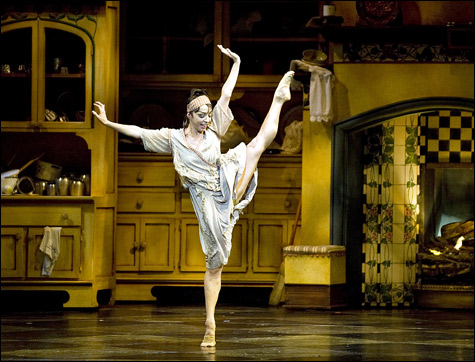
CUT-UP: Lorna Feijóo is an appealing Cinderella whether dancing in one toe shoe or two. |
Sergei Prokofiev’s two classical ballets invariably find Boston Ballet playing the dating game. Over the past 15 years, the company has gone through four different Romeo and Juliets and three different Cinderellas. For its previous Cinderella, in 1905, artistic director Mikko Nissinen chose James Kudelka’s 2004 version for the National Ballet of Canada. Set in the 1920s and inspired by Art Deco and Erté, this one’s a visual stunner — especially the second act in the Prince’s ballroom, with its pumpkin-colored Japanese lanterns and pumpkin-headed men in tuxes who pop up as the clock moves toward midnight. But it’s also light on myth and magic and heavy on morality. After seeing three performances in 2005, I suggested it was a good first date but not happily ever after. The Ballet didn’t agree: having kissed Kudelka’s Cinderella once, it’s going to kiss her again (through October 26 at the Wang Theatre). Maybe it’s getting tired of one-night stands.
Well, a good relationship does take time. So does our rags-to-riches heroine look any better the second time around? In a word, yes.

When it comes to psychological depth, Cinderella’s not as well-favored as her sister Romeo and Juliet or her stepsisters Swan Lake and The Sleeping Beauty. Her biggest asset is Prokofiev’s score, a looming nightmare that, with its ominous mazurka and bittersweet erotic waltzes, suggests that Cinderella’s happiness could at any moment burst like an overripe pumpkin. Michael Corder’s 1996 version (which Boston Ballet staged in 1997) used the waxing and waning moon as a metaphor for Cinderella’s dreams. Kudelka’s metaphor is the pumpkin, another symbol of organic growth and decay, but also a humble everyday item, like Cinderella herself. Her garden is her sanctuary from her Stepmother and her Stepsisters, the place where she grows herbs and vegetables. That’s where her Fairy Godmother takes her to receive the blessings and gifts of Blossom, Petal, Moss, and Twig (in some productions Spring, Summer, Fall, and Winter); it’s that quartet plus the “Garden Creatures” who shepherd her to the ball, and who warn her that the clock is about to strike midnight and all gardeners should be in bed — that’s the natural order of things. It’s appropriate, then, that Cinderella’s wedding to the Prince should take place not in his castle but in that garden. After which they settle down in front of her hearth (the rest of the kitchen set, the tallboy hutches and breakfronts, has been stripped away): she sits in a simple chair and he puts his head in her lap. Love isn’t all caviar and champagne.
In 2005, this Cinderella seemed all wit and wisdom, but either it’s wised up or I have. Kudelka does go for the easy laugh, and there’s some moralistic stereotyping. The “Bachelors” and “Ladies” who’ve been invited to the Prince’s ball represent the empty glitterati of society rather than the supportive community of almost every other story ballet. The Prince himself enters like a rock star, and his “Four Officers” look more like a bodyguard posse; they keep shunting the flashbulb-popping Photo Journalist away. (Never any respect for the press!) Prince and posse get their comeuppance in the third act when they scour the world with the glass slipper: one foreign lady after another isn’t interested in trying it on, and the Prince hits rock bottom when he starts to offer it to a woman with only one leg.
But there are real laughs, too. Cinderella’s Stepsister is a marcelled blonde-bombshell wanna-be, and her Other Stepsister (that’s what Kudelka calls them) is a myopic spazz. The Stepmother is a chainsmoking dipso, and the two men — “A Hired Escort” and “Another Hired Escort” — she engages to take her daughters to the ball come on like Gene Kelly and Fred Astaire even though between them they have four left feet. The ball guests go ga-ga and wind up looking in the wrong direction the first couple of times the Prince’s entrance is anticipated. (Did Kudelka get this idea from the “rooster entrance” in Frederick Ashton’s La Fille Mal Gardée?) Then they fracture Prokofiev’s mazurka into a kaleidoscope of jazzy ’20s dances. (One continuing puzzle: when Prokofiev quotes the famous march from his opera The Love for Three Oranges, you’d think the guests would be given oranges to underline the joke, but no.) At the wedding, the Stepsisters run on and fling themselves, one by one, at the Prince — whom they never really met — before being carried off in paroxysms of unrequited-love despair. And they remain in character during the curtain call: when, as is her prerogative, Cinderella as the leading lady steps forward to escort the orchestra conductor to center stage, the Stepsisters push her aside and grab him for themselves.